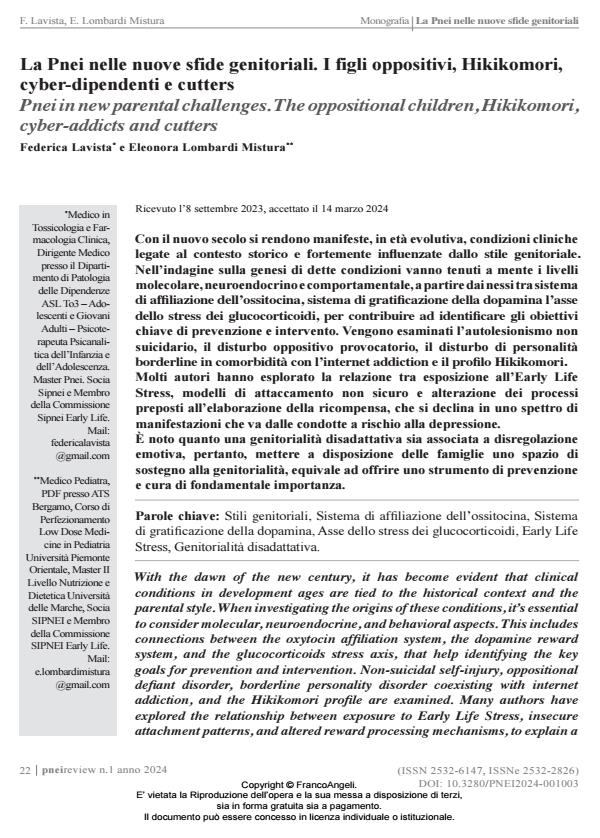La Pnei nelle nuove sfide genitoriali. I figli oppositivi, Hikikomori, cyber-dipendenti e cutters
Titolo Rivista PNEI REVIEW
Autori/Curatori Federica Lavista
Anno di pubblicazione 2024 Fascicolo 2024/1
Lingua Italiano Numero pagine 15 P. 22-36 Dimensione file 1144 KB
DOI 10.3280/PNEI2024-001003
Il DOI è il codice a barre della proprietà intellettuale: per saperne di più
clicca qui
Qui sotto puoi vedere in anteprima la prima pagina di questo articolo.
Se questo articolo ti interessa, lo puoi acquistare (e scaricare in formato pdf) seguendo le facili indicazioni per acquistare il download credit. Acquista Download Credits per scaricare questo Articolo in formato PDF

FrancoAngeli è membro della Publishers International Linking Association, Inc (PILA)associazione indipendente e non profit per facilitare (attraverso i servizi tecnologici implementati da CrossRef.org) l’accesso degli studiosi ai contenuti digitali nelle pubblicazioni professionali e scientifiche
Con il nuovo secolo si rendono manifeste, in età evolutiva, condizioni cliniche legate al contesto storico e fortemente in?uenzate dallo stile genitoriale. Nell’indagine sulla genesi di dette condizioni vanno tenuti a mente i livelli molecolare, neuroendocrino e comportamentale, a partire dai nessi tra sistema di af?liazione dell’ossitocina, sistema di grati?cazione della dopamina l’asse dello stress dei glucocorticoidi, per contribuire ad identi?care gli obiettivi chiave di prevenzione e intervento. Vengono esaminati l’autolesionismo non suicidario, il disturbo oppositivo provocatorio, il disturbo di personalità borderline in comorbidità con l’internet addiction e il pro?lo Hikikomori. Molti autori hanno esplorato la relazione tra esposizione all’Early Life Stress, modelli di attaccamento non sicuro e alterazione dei processi preposti all’elaborazione della ricompensa, che si declina in uno spettro di manifestazioni che va dalle condotte a rischio alla depressione. È noto quanto una genitorialità disadattativa sia associata a disregolazione emotiva, pertanto, mettere a disposizione delle famiglie uno spazio di sostegno alla genitorialità, equivale ad offrire uno strumento di prevenzione e cura di fondamentale importanza.�
Parole chiave:Stili genitoriali, Sistema di affiliazione dell’ossitocina, Sistema di gratificazione della dopamina, Asse dello stress dei glucocorticoidi, Early Life Stress, Genitorialità disadattativa.
Federica Lavista, La Pnei nelle nuove sfide genitoriali. I figli oppositivi, Hikikomori, cyber-dipendenti e cutters in "PNEI REVIEW" 1/2024, pp 22-36, DOI: 10.3280/PNEI2024-001003